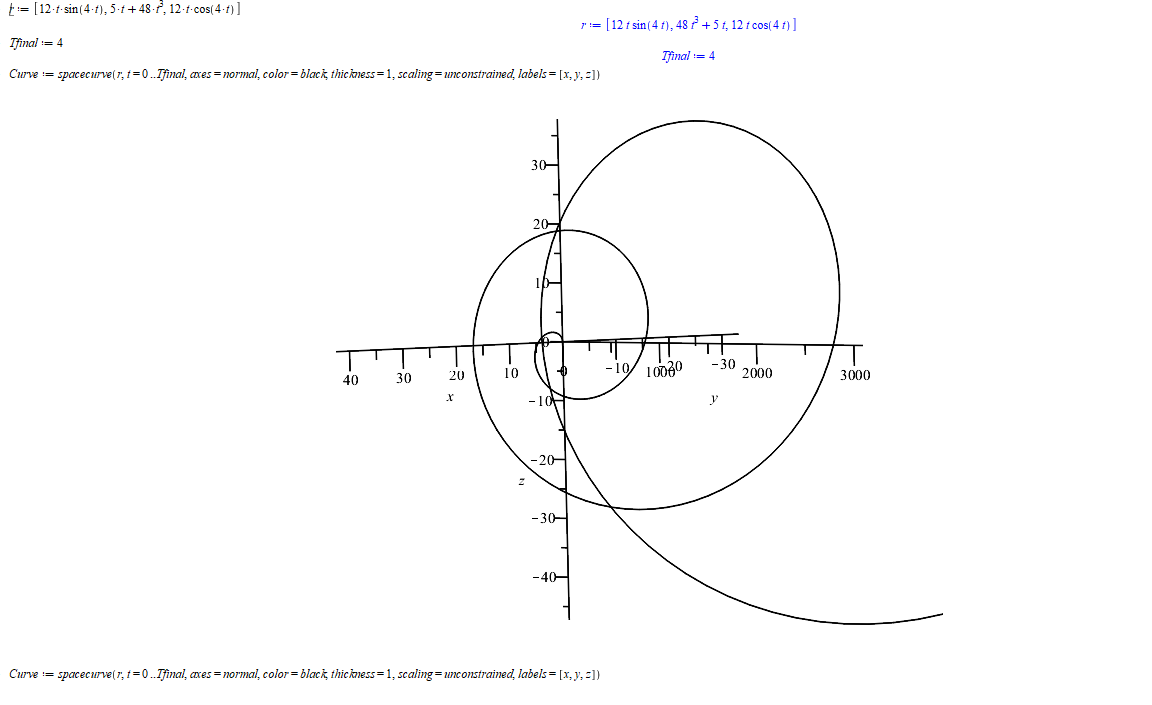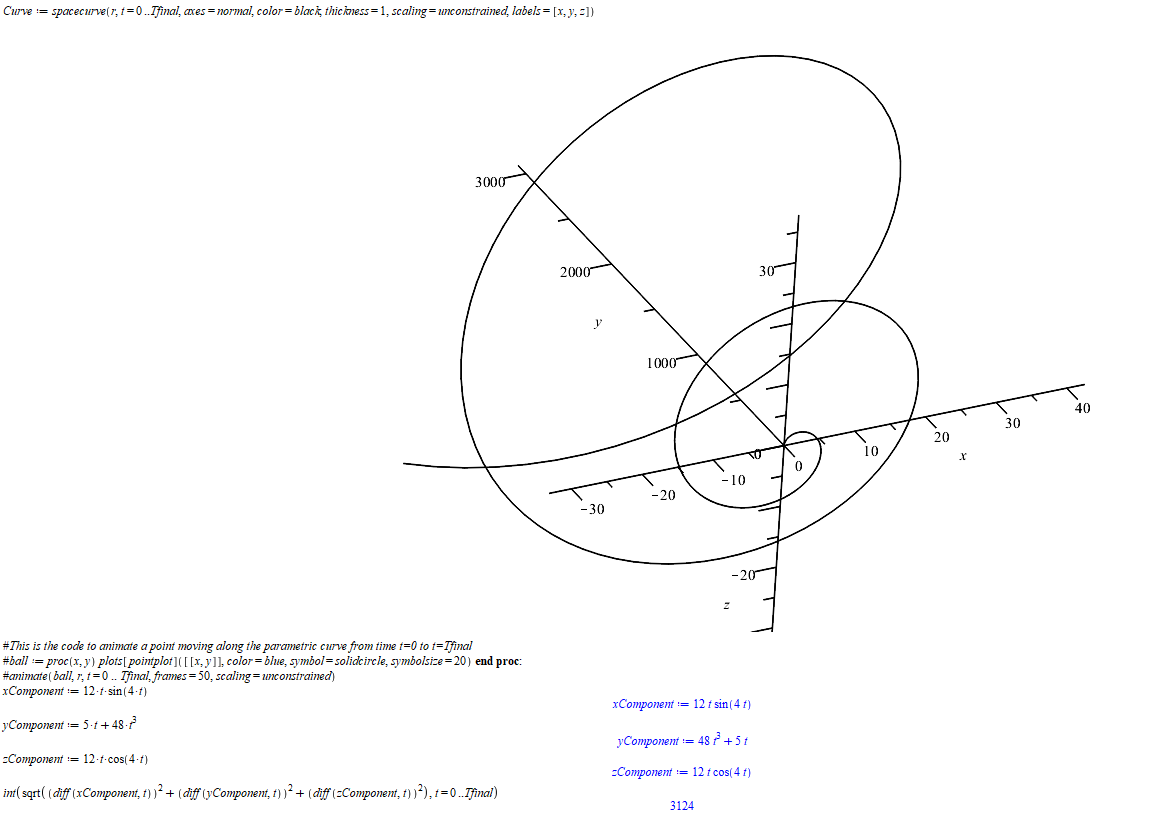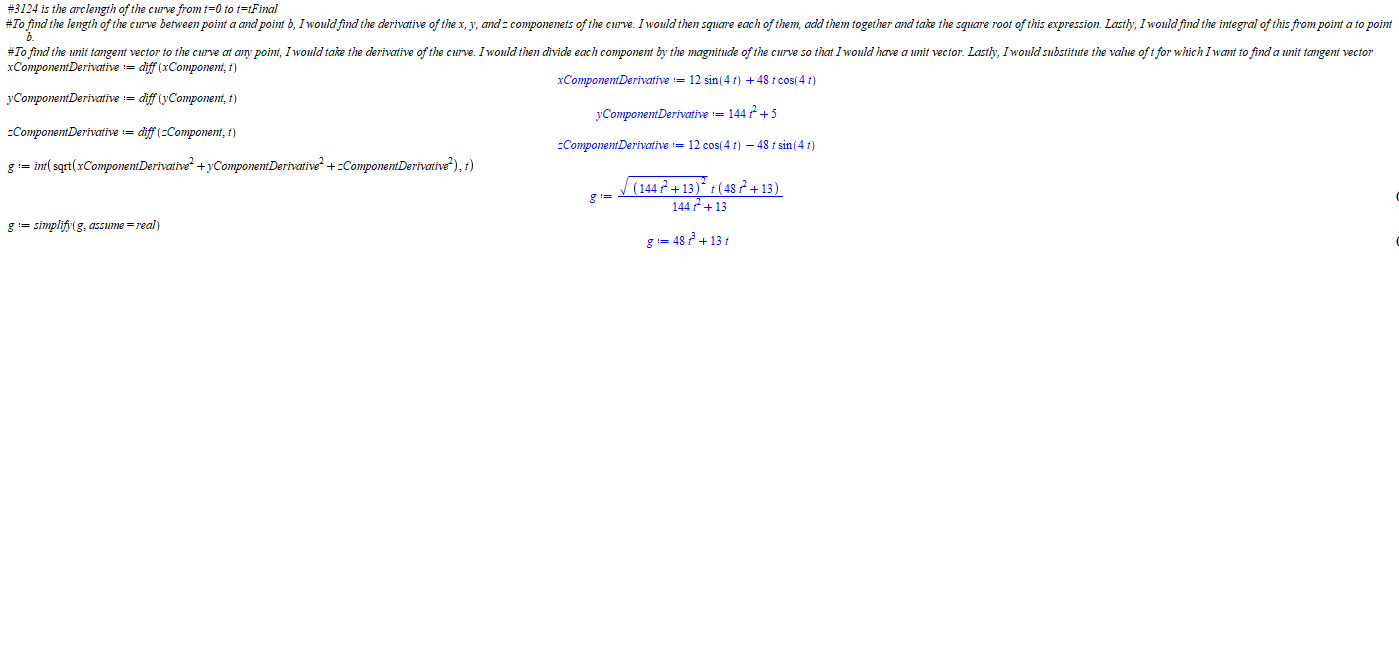Use Maple, Matlab, or Mathematica to
Draw and visualize a curve in three-dimensions, compute the length of this curve from t = 0 to t = Tf inal, and animate a point moving along the curve,
Find an arc-length parametrization for the curve, and
Animate the curve with this new parametrization and see how the point moves around the curve. Your code should consist of the following:
Storing the curve r1(t) and the final time Tf inal.
Two plots of the curve r1(t) showing the curve from different angles.
Code for an animation of a point moving around the curve at evenly spaced t values. You can comment this out when you go to print your final document, as printing an animation wont work out very well.
Compute the length of this curve.
In words/equations, answer the following questions: * If I were to give you two values t = a and t = b, what would the length of the curve r1 be between these points? * How would you find a unit tangent vector to the curve r1(t)?
Compute the function g(s) that is needed to find an arc-length parametrization of this curve, following all of the standard steps for doing this.
Find a formula (using the computer) for an arc-length parametrization r2(s). Define and store this function r2(s). What are the bounds on s?
Draw a plot of the curve r2(s) (it might look familiar), and write code to animate a point moving around this curve at evenly spaced s values.
Find the length of this curve. Hint: This should match your answer from earlier.
In words/equations, answer the following questions: * If I were to give you two values s = a and s = b, how would you compute the length of the curve r2 be between these points? * How would you find a unit tangent vector to the curve r2(s)? * What do you notice about the animations for r1 and r2? What is the difference between them?
I am having trouble with the bolded part of the assignment. I have completed all steps before it, but I cannot move on until I figure out how to do this. I managed to find a formula for the arc length in terms of t. Normally, you solve for t and substitute into the original equation, but I don't know how to isolate t. I would like my answer in Maple because that is the program I have been using for these labs. My professor says all of these labs can be completed with Maple. Here is the parametric equation I am working with: (12tsin(4t),48t^3+5t,12tcos(4t))


t= [12-1-sin(4-1),5-+48-7. 12.t-cos(4-1)] r := [12 f sin (41), 487 +51, 12 f cos(41)] Tfinal = 4 Tfinal := 4 Curve != spacecurver,t=0.Tfinal axes = normal, color=black thiciness=1, scaling = unconstrained labels = [x,y,]) T odo 40 30 20 10 4 -10 10080 -30 20 3000 -40 Curve := spacecurver,=0..Ifinal, cores = normal, color=black thickness=1, scaling = unconstrained labels = [x,y,2]) Curve := spacecurveir, 1=0..Ifinal, axes = normal, color=black thickness=1, scaling=unconstrained, labels=[x, y,-]) 3000m 2000 1000 30 40 10 20 -30 20 #This is the code to animate a point moving along the parametric curve from time t=0 to 1=Tfinal #ball := proc(x, y) plots[ pointplot]([(x,yll, color=blue, symbol=solidcircle, symbolsize=20) end proc: #animate ball, r, 1=0.. Tfinal, frames=50, scaling=wXconstrained) xComponent != 12-1.sin(4-1) xComponent := 12 sin(41) y Component := 5.1 +48 y Component = 487 +51 -Component := 12.t-cos(4-1) -Component := 12 f cos(41) int(sqrt( ( diff(xComponent, 1))2 + ( diff(yComponent, 1))2 + ( diff(-Component, 1))),t = 0...Ifinal) 3124 #3124 is the arclength of the curve from t=0 to t=tFinal #To find the length of the curve between point a and point 6, I would find the derivative of the x, y, and a componenets of the curve. I would then square each of them, add them together and take the square root of this expression. Lastly, I would find the integral of this from point a to point #To find the unit tangent vector to the curve at any point, I would take the derivative of the curve. I would then divide each component by the magnitude of the curve so that I would have a unit vector. Lastly, I would substitute the value of t for which I want to find a unit tangent vector xComponent Derivative = diff (xComponent, 1) xComponent Derivative = 12 sin(41) + 48f cos(41) yComponentDerivative := diff (yComponent, 1) y Component Derivative = 1442 +5 -Component Derivative != diff (-Component, 1) -Component Derivative = 12 cos(41) 48f sin(41) gi= int(sqrt(xComponent Derivative? + y Component Derivative? + -Component Derivative?), t) V (1442 +13) + (48 +13) 1447 +13 g: simplifyig, assume = real) g = 487 +131 t= [12-1-sin(4-1),5-+48-7. 12.t-cos(4-1)] r := [12 f sin (41), 487 +51, 12 f cos(41)] Tfinal = 4 Tfinal := 4 Curve != spacecurver,t=0.Tfinal axes = normal, color=black thiciness=1, scaling = unconstrained labels = [x,y,]) T odo 40 30 20 10 4 -10 10080 -30 20 3000 -40 Curve := spacecurver,=0..Ifinal, cores = normal, color=black thickness=1, scaling = unconstrained labels = [x,y,2]) Curve := spacecurveir, 1=0..Ifinal, axes = normal, color=black thickness=1, scaling=unconstrained, labels=[x, y,-]) 3000m 2000 1000 30 40 10 20 -30 20 #This is the code to animate a point moving along the parametric curve from time t=0 to 1=Tfinal #ball := proc(x, y) plots[ pointplot]([(x,yll, color=blue, symbol=solidcircle, symbolsize=20) end proc: #animate ball, r, 1=0.. Tfinal, frames=50, scaling=wXconstrained) xComponent != 12-1.sin(4-1) xComponent := 12 sin(41) y Component := 5.1 +48 y Component = 487 +51 -Component := 12.t-cos(4-1) -Component := 12 f cos(41) int(sqrt( ( diff(xComponent, 1))2 + ( diff(yComponent, 1))2 + ( diff(-Component, 1))),t = 0...Ifinal) 3124 #3124 is the arclength of the curve from t=0 to t=tFinal #To find the length of the curve between point a and point 6, I would find the derivative of the x, y, and a componenets of the curve. I would then square each of them, add them together and take the square root of this expression. Lastly, I would find the integral of this from point a to point #To find the unit tangent vector to the curve at any point, I would take the derivative of the curve. I would then divide each component by the magnitude of the curve so that I would have a unit vector. Lastly, I would substitute the value of t for which I want to find a unit tangent vector xComponent Derivative = diff (xComponent, 1) xComponent Derivative = 12 sin(41) + 48f cos(41) yComponentDerivative := diff (yComponent, 1) y Component Derivative = 1442 +5 -Component Derivative != diff (-Component, 1) -Component Derivative = 12 cos(41) 48f sin(41) gi= int(sqrt(xComponent Derivative? + y Component Derivative? + -Component Derivative?), t) V (1442 +13) + (48 +13) 1447 +13 g: simplifyig, assume = real) g = 487 +131









